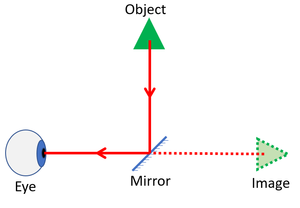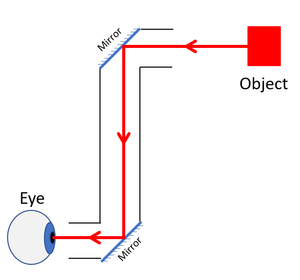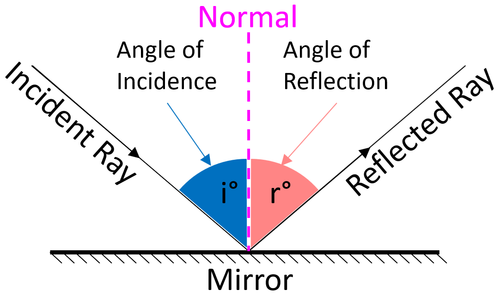Difference between revisions of "Mirror"
(→Examples) |
|||
| Line 12: | Line 12: | ||
{| class="wikitable" | {| class="wikitable" | ||
|- | |- | ||
| − | |[[File:MirrorDiagram.png|center| | + | |[[File:MirrorDiagram.png|center|300px]] |
| − | |[[File:PeriscopeDiagram.png|center| | + | |[[File:PeriscopeDiagram.png|center|300px]] |
|- | |- | ||
| − | | style="height:20px; width: | + | | style="height:20px; width:300px; text-align:center;" |This '''mirror''' makes it look like the triangle is in front of the eye, but it is not. |
| − | | style="height:20px; width: | + | | style="height:20px; width:300px; text-align:center;" |A periscope uses the [[Specular Reflection|reflection]] from two '''mirrors''' to see a clear image. |
|} | |} | ||
Revision as of 09:50, 21 October 2018
Contents
Key Stage 2
Meaning
A mirror is a shiny surface used to reflect the image of an object.
About Mirrors
- Mirrors are usually made of metal because it is shiny. The metal is sometimes covered in glass to protect the metal.
- A mirror can be used to change the direction of light by reflecting it.
- A mirror makes an object look like it's in a place that it is not.
Examples
| This mirror makes it look like the triangle is in front of the eye, but it is not. | A periscope uses the reflection from two mirrors to see a clear image. |
Key Stage 3
Meaning
A mirror is a shiny surface used to reflect the image of an object.
About Mirrors
- Mirrors are usually made of metal because it is shiny. The metal is sometimes covered in glass to protect the metal.
- A mirror can be used to change the direction of light by reflecting it.
- A mirror makes an object look like it's in a place that it is not.
- Reflection from a mirror follows the Law of Reflection.
| When a ray of light strikes a mirror it is reflected by the same angle that it arrives. |


